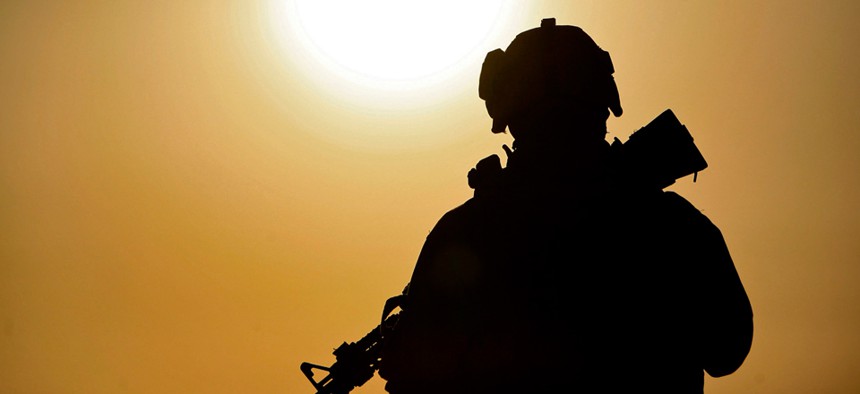
Defense Department file photo
Barack Obama delivered a bewildering speech on Wednesday. The pledge to "destroy" the Islamic State of Iraq and Syria; the deployment of U.S. troops to do just that; the flag-flanked, sober-sounding president addressing the American people behind a podium in prime-time—all appeared to amount to a declaration of war.
But Obama never used the word "war" to describe his decision to launch airstrikes against ISIS and provide military assistance to regional forces fighting the extremist group. When he employed the w-word, it was to clarify what this is not. It's not "another ground war in Iraq." It's not Afghanistan. It's a "counterterrorism campaign" to "take out ISIL wherever they exist." Obama didn't say how long the campaign would take, or how we'll know when its mission is accomplished.
The effect was to thoroughly blur the boundary between peacetime and wartime. And maybe that was on purpose. After all, it was less than a year and a half ago that Obama promised, in an address at National Defense University, to remove America from the "perpetual war footing" it had assumed since the September 11 attacks. On Wednesday night, he seemingly tried to honor that pledge while simultaneously preparing the country for military operations against ISIS. Did the president announce a war? A military action? Targeted strikes? Are there meaningful differences between these terms? It's not all that clear.
In the 13 years since 9/11, Americans have grown accustomed to the ambiguity of U.S. efforts to deter, disrupt, and preempt the threats posed by a shape-shifting cast of terrorist groups. The ebbs and flows of America's inexorable counterterrorism campaigns have produced a tangled web of terminology. For evidence, take a look at the many ways the New York Times homepage referred to Obama's intervention on Thursday:

What Obama didn't quite foresee at National Defense University in 2013 was a group like ISIS, which had yet to split with al-Qaeda and seize vast tracts of territory. Instead, his vision of terrorism's future included "lethal yet less capable al Qaeda affiliates; threats to diplomatic facilities and businesses abroad; [and] homegrown extremists." The United States, he said, could not combat these actors with force alone:
We cannot use force everywhere that a radical ideology takes root; and in the absence of a strategy that reduces the wellspring of extremism, a perpetual war—through drones or Special Forces or troop deployments—will prove self-defeating, and alter our country in troubling ways.
Obama also called for the repeal of the 2001 Authorization for Use of Military Force (AUMF) against "those responsible" for the 9/11 attacks—language often interpreted as referring to al-Qaeda and its "associated forces." If America had adopted a perpetual war footing, he argued, the AUMF was the foundation on which it stood.
This week, however, perpetual war appeared to get the best of Obama. Administration officials are reportedly invoking the AUMF as a legal justification for the U.S. campaign against ISIS. As The Daily Beast 's Eli Lake explains , that means, incredibly, that a resolution designed to justify attacks on al Qaeda-linked groups "would also apply to a terrorist organization that is itself at war with al Qaeda." The definition of "those responsible" for 9/11 expands and explodes. The perpetual war continues. What Obama might have called "war footing" in 2013, he described Wednesday as a "comprehensive and sustained counterterrorism strategy."
The question of whether the AUMF applies to U.S. military intervention in Iraq and Syria is part of a larger debate over whether the campaign is lawful, and whether it requires congressional authorization. But that debate, in turn, is partially a reflection of the merging of peacetime and wartime, and the resulting confusion about which legal frameworks apply to which actions.
The boundary between peace and war was already dissolving in 2002, when The West Wing aired an episode on this very phenomenon. In the scene below, Admiral Percy Fitzwallace, the joint chiefs chairman, makes the case for killing the defense minister of the fictional Middle Eastern country of Qumar, who is believed to be plotting terrorist attacks against the United States.
"Can you tell when it's peacetime and wartime anymore?" Fitzwallace asks. "We measure the success of a mission by two things: Was it successful and how few civilians did we hurt. They measure success by how many. Pregnant women are delivering bombs. You're talking to me about international laws? The laws of nature don't even apply here." Legal systems that clearly distinguish between peacetime and wartime, he argues, are antiquated and meaningless in today's grinding battle against brutal terrorists.
The distinctions between war and peace, of course, have long been murky (think America's "police action" in Vietnam during another seemingly endless conflict: the Cold War). And few declarations of war are as clear as, say, those issued during World War II . Obama, moreover, has been careful to present his counterterrorism measures as limited to specific groups in specific places that pose specific threats to the United States—rather than, in his words, a "boundless 'global war on terror.'"
But over the course of his presidency, these efforts have expanded from Pakistan and Yemen to Somalia, and now to Iraq and Syria. "This war, like all wars, must end," Obama declared at National Defense University. This week, the president set aside that goal. Thirteen years after his predecessor declared war on a concept—terror—Obama avoided explicitly declaring war on the very real adversary ISIS has become. All the same, U.S. soldiers are now going on the offensive again in the Middle East. What is the nature of their enemy? Is it peacetime or wartime? After Wednesday's speech, it's more difficult than ever to tell.







